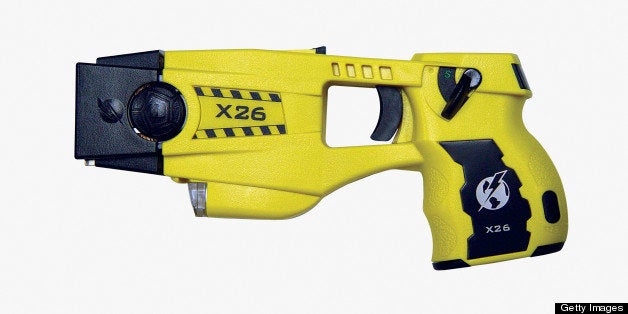
Here's a question for all of you law abiding folks out there. Have you ever been shot by the cops with a Taser stun gun? I have. I once got zapped with 50,000 volts from an X26 Taser and it hurt like a son of a bitch. But my beef with the stun gun, the Taser, isn't personal, it's political. This is because Tasers, "conducted energy weapons", have become a public health and safety issue. Marketed as a "non-lethal weapon", Tasers are anything but. People, black and white, young and old, are dying because of them. And it's not just happening in the USA, it's happening all over the world.
Though it has been around for forty plus years, the Taser is a very mysterious weapon indeed, one that We the People don't know much about. Who invented this Star Trek style phaser gun? And why does one firm in Arizona, TASER International, have the monopoly on supplying them to 107 countries and 18,000 law enforcement agencies worldwide? Here's the potted history. A retired NASA physicist called Jack Cover invented the first Taser in 1969; by 1977, cops all over the USA were testing them in the field; in 1993, a pair of entrepreneur brothers, Rick and Tom Smith, licensed the technology from Cover and founded TASER International. The Smith boys improved the weapon's trigger mechanism, its accuracy, and, controversially, its stopping power. Cover's model operated on a five-watt system that lacked the knockdown punch to stop "motivated people". To compensate, the boffins at TASER International pumped up the output of the device four times and the charge three times. It was powerful. It did the trick. But was it fit for public consumption?
With bankruptcy looming for the Smith boys at TASER International in 1999, their product was rushed into service. It was a glorious success. The M26 Taser was hailed as the product that changed the face of law enforcement. It did so because it gave cops an option other than lethal force. No muss, no fuss, pull out the Taser. But there was never any regulation of the product, and, for some inexplicable reason, the M26, and its successor the X26, has never been inspected by any electrical standards body in the world. Moreover, all of the information and data on the product that law enforcement agencies were relying on came from the manufacturer's team of in-house experts. Hmm, it doesn't take a Lt. Colombo or Dixon of Dock Green to ask the logical question here: should cops be taking the company at their word and using its "non-lethal" product? No, perhaps not. Cops did OK before the advent of the Taser, and Tasers are anything but risk free.
Here's why. Cops are trained to shoot people in the "center mass" area (the chest) of the human body. And death by Taser is often caused by multiple discharges of the weapon in this specific region. This is significant. All of the field studies on Tasers rely on the findings of the effects of a single five-second charge to the human body, not multiple exposures. That said, it does not take a multiple discharge of the Taser to kill a human being. There are numerous instances of cardiac arrest from a single shot of the stun gun. One example is the case of Robert Mitchell, a sixteen year old from Michigan who was shot in the chest with one five-second zap of the Taser in 2009. He immediately collapsed and died. TASER International took note of this, and other such fatalities, and updated their manuals with advice to avoid shooting people in the chest. The one-eighty was a bit of a tall order from the suits at TASER International for the cops. Shooting someone with a Taser in the arm, or the leg, is much harder in the live theater of policing than good old "center mass".
Whenever the crime-fighting folks at TASER International are queried about their best-selling product, they always insist that it's safe. It does not kill. And, when it does, it's due to a preexisting heart condition or some other medical anomaly. Despite the growing death toll, lawsuits, inquiries and innumerable vids of Taser happy cops on YouTube, TASER International, who generated a record $162 million in 2015, is still doing great biz in 2016. And when it comes to scrutiny of their product, they concede nothing and rebuke everything. To do otherwise would be to lose face, to do otherwise would be bad for biz. Their best selling stun gun is legit. It saves lives and prevents terrorism. The public has nothing to fear. And so TASER International, hiding behind its phalanx of in-house experts and quibbling lawyers, remains a business in denial, and members of the public keep dying, worldwide, because of their "non-lethal" product. Until modified, replaced or gotten rid of entirely, the Taser, the weapon that only kills sometimes, will remain a public health and safety issue for citizens everywhere.
